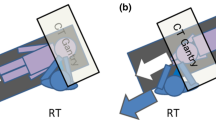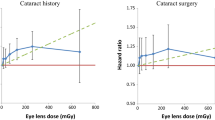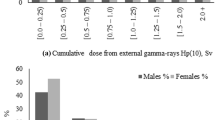Abstract
Evaluation has been made of the radiogenic risks to patients and personnel during 99mTc diagnostic nuclear medicine examinations. A highly sensitive form of thermoluminescent dosimeter, type TLD-GR200A (LiF: Mg, Cu, P), was used to quantify occupational exposure. Ambient exposure rates and patient doses were also assessed using a survey meter and knowledge of the administered activity respectively. For bone, renal and thyroid scans, the mean 99mTc administered activities were 925.0 MBq, 148.0 MBq and 166.5 MBq respectively. The staff annual dose was estimated to be 11.2 mSv and eye lens dose equivalent was 2.2 mSv. The dose values are greater in comparison with other studies but with the current workload and practices they remain within the annual occupational dose limit.
Similar content being viewed by others
References
Rösch F, Herzog H, Qaim SM (2017) The beginning and development of the theranostic approach in nuclear medicine, as exemplified by the radionuclide pair 86Y and 90Y. Pharma (Basel) 10(2):1–28
Mettler FA, Bhargavan M, Faulkner K, Gilley DB, Gray JE, Ibbott GS, Lipoti JA, Mahesh M, McCrohan JL, Stabin MG, Thomadsen BR, Yoshizumi TT (2009) Radiologic and nuclear medicine studies in the United States and worldwide: frequency, radiation dose, and comparison with other radiation sources-1950–2007. Radiology 253:520–531. https://doi.org/10.1148/radiol.2532082010
Sudbrock F, Uhrhan K, Rimpler A, Schicha H (2011) Dose and dose rate measurements for radiation exposure scenarios in nuclear medicine. Radiat Meas 46(11):1303–1306. https://doi.org/10.1016/j.radmeas.2011.06.074
Alnaaimi M, Alkhorayef M, Omar M, Abughaith N, Alduaij M, Salahudin T, Alkandri F, Sulieman A, Bradley D (2017) Occupational radiation exposure in nuclear medicine department in Kuwait. Radiat Phys Chem 140:233–236. https://doi.org/10.1016/j.radphyschem.2017.02.048
Javadi H, Pashazadeh A, Mogharrabi M, Asli I, Tabei F, Parach A, Assadi M (2013) Radiation exposure from diagnostic nuclear medicine examinations in Golestan province. Iran J Nucl Med 21(2):65–69
Nassef M, Kinsara A (2017) Occupational radiation dose for medical workers at a University Hospital. JTUSCI 11(6):1259–1266. https://doi.org/10.1016/j.jtusci.2017.01.003
Alramlawi S, Alsaqr A, AL Zayat D, Galal M (2015) Assessing the occupational radiation doses for medical workers at Cairo University Hospital based on job categories. AJNSA 48(1):40–43
Martins MB, Alves JN, Abrantes JN, Roda AR (2007) Occupational exposure in nuclear medicine in Portugal in the 1999–2003 period. Radiat Prot Dosim 125:130–134. https://doi.org/10.1093/rpd/ncl564
Al-Abdulsalam A, Brindhaban A (2014) Occupational radiation exposure among the staff of Departments of Nuclear Medicine and Diagnostic Radiology in Kuwait. Med Princ Pract 23:129–133. https://doi.org/10.1159/000357123
Neriishi K, Nakashima E, Minamoto A, Fujiwara S, Akahoshi M, Mishima HK, Kitaoka T, Shore RE (2007) Postoperative cataract cases among atomic bomb survivors: radiation dose response and threshold. Radiat Res 168:08–404. https://doi.org/10.1667/RR0928.1
Ciraj-Bjelac O, Rehani M, Sim H, Liew B, Vano E, Kleiman N (2010) Risk for radiation induced cataract for staff in interventional cardiology: is there reason for concern? Catheter Cardiovasc Interv 76:826–834. https://doi.org/10.1002/ccd.22670
Rehani M, Vano E, Ciraj-Bjelac O, Kleiman J (2011) Radiation and cataract. Radiat Prot Dosim 147:300–304. https://doi.org/10.1093/rpd/ncr299
Rehani M (2015) Eye dose assessment and management: overview. Rad Prot Dosim 165(1–4):276–278. https://doi.org/10.1093/rpd/ncv048
International Commission on Radiological Protection (2012) ICRP statement on tissue reactions/early and late effects of radiation in normal tissues and organs threshold doses for tissue reactions in a radiation protection context Publication 118 ICRP 41: (1/2)
International Commission on Radiological Protection (2007) The 2007 recommendations of the International Commission on Radiological Protection. ICRP Publication 103. Ann. ICRP 37 (2–4)
National council on Radiation protection and measurements (1995) Use of personal monitors to estimate effective dose equivalent and effective dose to workers for external exposure to low LET radiation. NCRP Report No. 122. Bethesda, USA
Mettler FA, Huda W, Yoshizumi TT, Mahesh M (2008) Effective doses in radiology and diagnostic nuclear medicine: a catalog. Radiology 248(1):63–254. https://doi.org/10.1148/radiol.2481071451
Shen W, Tang K, Zhu H, Liu B (2002) New advances in LiF:Mg, Cu, P TLDs (GR-200A). Radiat Prot Dosim 100:60–357
Hjelstuen OK (1995) Technetium-99 m chelators in nuclear medicine. A Rev Anal 120(3):863–866
Hamza Y, Sulieman A, Abuderman A, Alzimami K, Omer H (2015) Evaluation of patient effective doses in CT urography, intravenous urography and renal scintigraphy. Radiat Prot Dosim 165(1–4):452–456
Piwowarska-Bilska H, Birkenfeld B, Gwardyś A, Supińska A, Listewnik M, Elbl B, Cichoń-Bańkowska K (2011) Occupational exposure at the Department of Nuclear Medicine as a work environment: a 19-year follow-up. Pol J Radiol 76(2):18–21
Acknowledgements
The authors extend their appreciation to the Deanship of Scientific Research at King Saud University for funding of this work through research group scheme No (RG-1438-072).
Author information
Authors and Affiliations
Corresponding author
Rights and permissions
About this article
Cite this article
Sulieman, A., Yousif, E., Alkhorayef, M. et al. Lens dose and radiogenic risk from 99mTc nuclear medicine examinations. J Radioanal Nucl Chem 318, 797–801 (2018). https://doi.org/10.1007/s10967-018-6178-5
Received:
Published:
Issue Date:
DOI: https://doi.org/10.1007/s10967-018-6178-5




